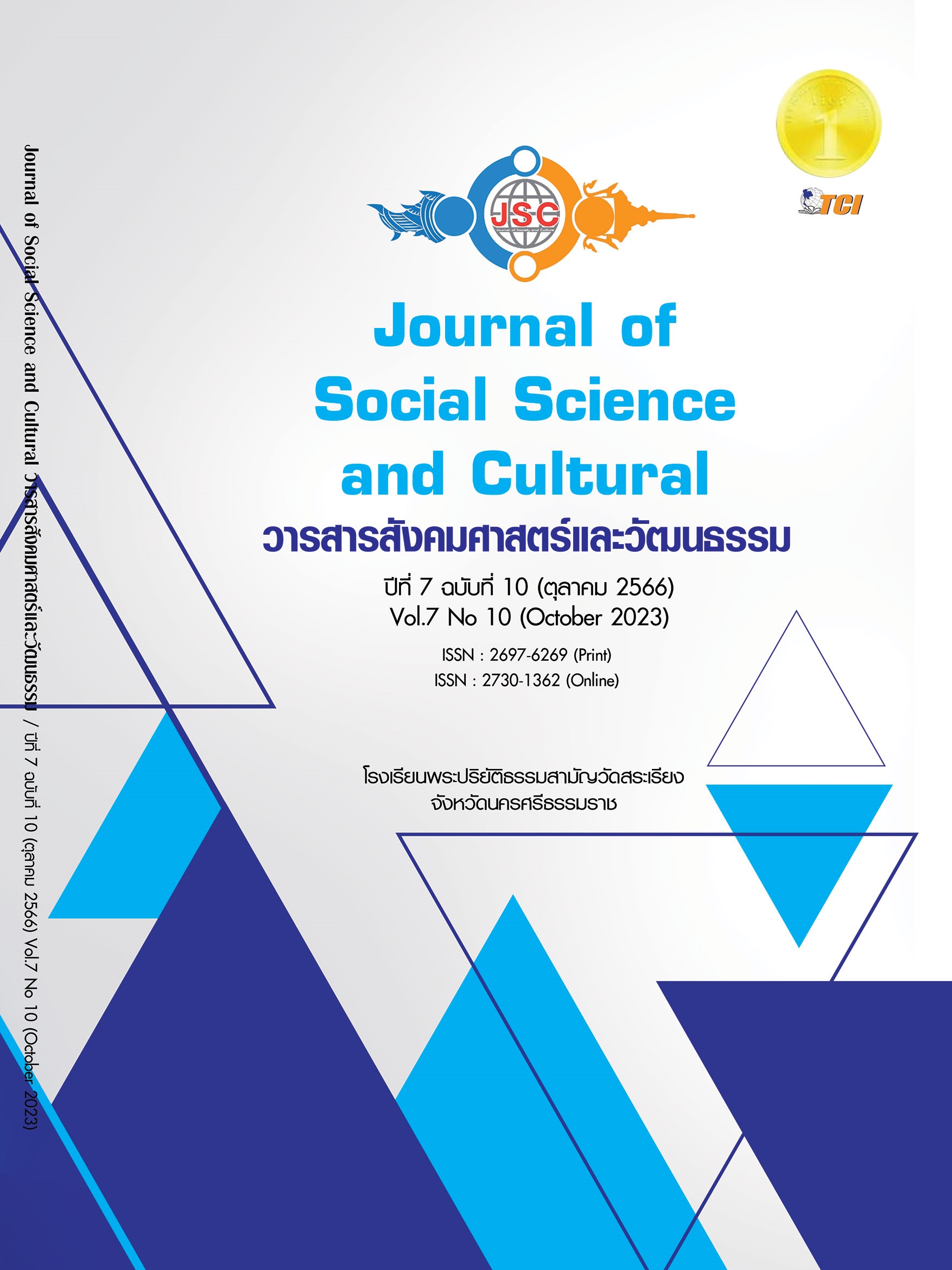NEW NORMAL WORK SKILLS THAT AFFECTED THE BURNOUT OF UNIVERSITY’S NON-ACADEMIC PERSONNEL IN SONGKHLA PROVINCE
Main Article Content
Abstract
The research purposes were to study 1) new normal work skills 2) burnout factors and 3) new normal work skills affect to the burnout of non-academic personnel in Songkhla province. The sample population were 400 non-academic personnel in Songkhla. This research is quantitative research with questionnaires as a tool to collect data. Statistics used in data analysis include percentage, mean, standard deviation, correlation, and multiple regression analysis. The research results found that overall and each item new normal work skills were found to be at a high average level. The overall burnout factor was found to be at a high average level. Moreover, new normal work skills affected to burnout of non-academic personnel in university, Songkhla that were new normal work skills in digital and information usage, creation, and integration as well as plan and problem decision were positive effect on the burnout overall statistically at the 0.05 level. Moreover, adaptability and flexibility were not affected on the burnout overall statistically at the 0.05 level. The research results can be utilized for organization plan about human resource development in terms of necessary work skills and organized activities that help create happiness for reduced burnout problem of non-academic personnel in university, Songkhla.
Article Details
References
เปรมกมล อินไชยา และพิชญา พรรคทองสุข. (2564). ปัจจัยที่เกี่ยวข้องกับภาวะหมดไฟของพนักงานในโรงพยาบาลเอกชนแห่งหนึ่งในจังหวัดสงขลา. วารสารศูนย์การศึกษาแพทยศาสตร์คลินิก โรงพยาบาลพระปกเกล้า, 38(2), 142-151.
กมลพร กัลยาณมิตร. (2564). ทักษะจำเป็นแห่งอนาคตการทำงานยุคหลังโควิด-19. วารสาร มจร พุทธปัญญาปริทรรศน์, 6(3), 163-176.
กาญจนา วานิชกร. (2564). ทักษะมนุษย์-แรงงานที่จำเป็นสำหรับประเทศไทยในโลกหลังโควิด-19. เรียกใช้เมื่อ 17 กรกฎาคม 2566 จาก https://www.mhesi.go.th/index.php/news/4918-19-38.html.
ธนชาติ นุ่มนนท์. (2563). การมีวัฒนธรรมองค์กรดิจิทัลเพื่อเข้าสู่นโยบายไทยแลนด์ 4.0 ได้สำเร็จ. เรียกใช้เมื่อ 7 กรกฎาคม 2566 จาก https://thanachart.org/digital-culture.
นครินทร์ ชุนงาม. (2563). สุขภาพจิตและภาวะหมดไฟในการทำงานของแพทย์ในโรงพยาบาลทั่วไปและโรงพยาบาลชุมชน จังหวัดนครราชสีมา. วารสารสุขภาพจิตแห่งประเทศไทย, 28(4), 348-359.
นักสิทธ์ ศักดาพัฒน์. (2566). ปัจจัยทางจิตสังคมที่เกี่ยวข้องกับทักษะการทำงานร่วมกับผู้อื่นในชีวิตวิถีใหม่ของนักศึกษาระดับปริญญาตรี. วารสารพฤติกรรมศาสตร์เพื่อการพัฒนา, 15(1), 83-107.
นิชชุนันท์ ประสารพันธ์ และคณะ. (2564). ภาวะหมดไฟในการทำงานและปัจจัยที่เกี่ยวข้องของบุคลากรในโรงพยาบาลเอกชน กรุงเทพมหานคร. วารสารพยาบาลสาธารณสุข, 35(3), 48-63.
นิรัช สุดสังข์. (2559). ระเบียบวิธีวิจัยทางการออกแบบ. (พิมพ์ครั้งที่ 1). กรุงเทพมหานคร: โอเดียนสโตร์.
ปิยะวดี สุมาลัย. (2564). ภาวะหมดไฟในการทำงานของพยาบาลวิชาชีพ สถาบันบำราศนราดูร. วารสารวิทยาลัยพยาบาลพระจอมเกล้า จังหวัดเพชรบุรี, 4(2), 66-78.
พรชัย สิทธิศรัณย์กุล. (2563). ภาวะหมดไฟไม่ใช่โรค แต่เป็นปรากฏการณ์เหตุอาชีพ. Chula Med Bull, 2(2), 115-119.
อันธิกา ปริญญานิลกุล และคณะ. (2563). ทักษะดิจิทัลที่จำเป็นต่อการปฏิบัติงานของผู้ประกอบวิชาชีพในธุรกิจโรงแรมไทย: กรณีศึกษาโรงแรมในเครือดุสิตอินเตอร์เนชั่นแนลในเขต กรุงเทพมหานคร (รายงานการวิจัย). กรุงเทพมหานคร: วิทยาลัยดุสิตธานี.
อานุภาพ เลขะกุล. (2564). ความปกติถัดไปอุดมศึกษา: ความท้าทาย. วารสารการศึกษาและนวัตกรรมการเรียนรู้, 1(2), 111-125.
อิทธิพร ขำประเสริฐ. (2564). การทำงานที่บ้านของบุคลากรสายสนับสนุนวิชาการ: แนวคิด และประสบการณ์. วารสารวิชาการ ปขมท, 10(2), 35-46.
Abbas, M. & Raja, U. (2015). Impact of psychological capital on innovative performance and job stress. Canadian Journal of Administrative Sciences, 32(2), 128-138.
Armstrong, J. S. & Overton, T. S. (1977). Estimating nonresponse bias in mail surveys. Journal of Marketing Research, 14(3), 396-402.
Aro, K. S. & Read, S. (2017). Study engagement and burnout profiles among Finnish higher education students. Burnout Research, 7(1), 21-28.
Azoulay, E., et al. (2020). Symptoms of burnout in intensive care unit specialists facing the COVID-19 outbreak. Annals of Intensive Care, 10(1), 2-8.
Barello, S., et al. (2020). Burnout and somatic symptoms among frontline healthcare professionals at the peak of the Italian COVID-19 pandemic. Journal of Psychiatric Research, (11), 2-4. https://doi.org/10.1016/j.psychres.2020.113129.
Bradley, M. & Chahar, P. (2020). Burnout of healthcare providers during COVID-19. Cleveland Clinic Journal of Medicine, https://doi.org/10.3949/ccjm.87a.ccc051.
Christina, M. & Susan, E. J. (1986). Maslach Burnout Inventory Manual (2 nd ed). Palo Alto, CA: Consulting Psychologists Press.
Derakhshanrad, S. A., et al. (2019). The Relationships between Problem-Solving, Creativity, and Job Burnout in Iranian Occupational Therapists. Occupational Therapy in Health Care, 33(4), 365-380.
Hair, J. F., et al. (2018). Multivariate Data Analysis (8 nd ed). England: Pearson Prentice.
Hernández, L. A., et al. (2019). Stress, self-efficacy, academic achievement and resilience in emerging adults. Electronic Journal of Research in Educational Psychology, 17(1), 129-148.
Janatolmakan, M., et al. (2021). Comparison of Knowledge, Attitude, and Practice of Nursing and Medical Students in Kermanshah, Iran, about Toothbrush Maintenance and Use. Journal of Environmental and Public Health, 16, 1-7. https://doi.org/10.1155/2021/6669029.
Ju, D., et al. (2016). Boundary conditions of the emotional exhaustion-unsafe behavior link: The dark side of group norms and personal control. Asia Pacific Journal of Management, 33(1), 113-140.
Kato, K. (2022). The Impact of Work-From-Home (WFH) of Male Full-time Workers under COVID-19 on Their Work-Life-Balance (WLB) Attitude. Journal of ASEAN PLUS+ Studies, 3(2), 35-47.
Laschinger, H. & Fida, R. (2014). New nurses burnout and workplace wellbeing: The influence of authentic leadership and psychological capital. Burnout Research, 1(1), 19-28.
Lemonaki, R., et al. (2021). Burnout and job performance: a two-wave study on the mediating role of employee cognitive functioning. European Journal of Work and Organizational Psycholog, 30(5), 692-704.
Margaryan, A., et al. (2011). Are digital natives a myth or reality? University students’ use of digital technologies. Computers & education, 56(2), 429-440.
Marr, B. (2020). Future predictions for a post-coronavirus world. NSW Doctor, 12(3), 19-20.
Marzal, M. A. & Cruz, P. E. (2018). Gaming como Instrumento Educativo para una Educación en competencias Digitales desde los Academic Skills Centres. Revista General de Información y Documentación, 28(2), 489-506.
Römgens, I. S., et al. (2019). Unraveling the concept of employability, bringing together research on employability in higher education and the workplace. Studies in Higher Education, 45(12), 2588-2630.
Valiūnienė, V. K., et al. (2021). Influence of Digital Competence on Perceived Stress, Burnout and Well-Being Among Students Studying Online During the COVID-19 Lockdown: A 4-Country Perspective. Psychology Research Behavior Management, 14, 1483-1498. https://doi.org/ 10.2147/PRBM.S325092.
Verma, S. & Gustafsson, A. (2020). nvestigating the emIerging COVID-19 research trends in the field of business and management: A bibliometric analysis approach. Journal of Business Research, 118, 253-261. https://doi.org/10.1016/j.jbusres.2020.06.057.
Yamane′, T. (1973). Statistics: an introductory analysis. New York: Harper & Row.
Yang, S. & Wang, W. (2022). The Role of Academic Resilience, Motivational Intensity and Their Relationship in EFL Learners’ Academic Achievement. Front Psychol, 12, 1-8. https:// doi.org/10.3389/fpsyg.2021.823537.


